Walnut Vs Mahogany: Which of The Two Suits Your Project Better?
Hardwood has many uses, from flooring, paneling, cladding, and fencing to making boats. With over two dozen types of hardwoods in the world, it can be difficult to determine the suitable choice. However, walnut and mahogany are two common hardwood options.
But how do you compare walnut vs mahogany? Walnut and mahogany vary in various ways, including appearance, availability, and cost. They also suit different projects based on their durability and color. The project type and personal preferences are some factors that determine the hardwood to use.
The article discusses walnut and mahogany woods, listing their similarities, differences, and projects that suit them. Read on to learn more.
Walnut Vs Mahogany Quick Comparison
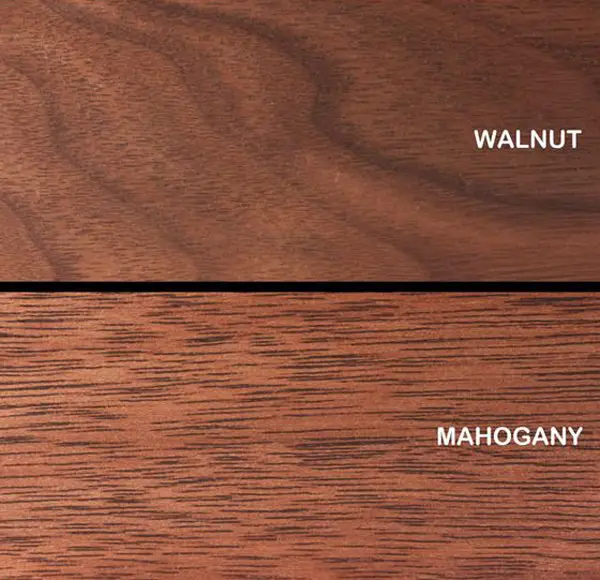
The following table compares walnut and mahogany wood based on various factors.
| Factor | Walnut | Mahogany |
|---|---|---|
| Appearance | Light brown to dark chocolate color | Reddish brown color |
| Grain pattern | Subtle and close grains | Straight and close grains |
| Hardness (Janka hardness rating) | 1,010 lbf (Black walnut) | 800 lbf/2,200 lbf (Santos Mahogany) |
| Uses | FurnitureCabinetry | Musical instrumentsBoat building |
| Cost (per square foot) | $2 to $8 | $6 to $10 |
Walnut Vs Mahogany Comparison
As mentioned earlier, walnut and mahogany are hardwoods, which makes them a good choice for most wood jobs.
Walnut

Walnut trees are any species of tree of the plant genus Juglans and family Juglandaceae. This genus has over 20 species, and the popular ones used by woodworkers include black and English. Their popularity is because they are strong and more abundant than other species.
Mahogany
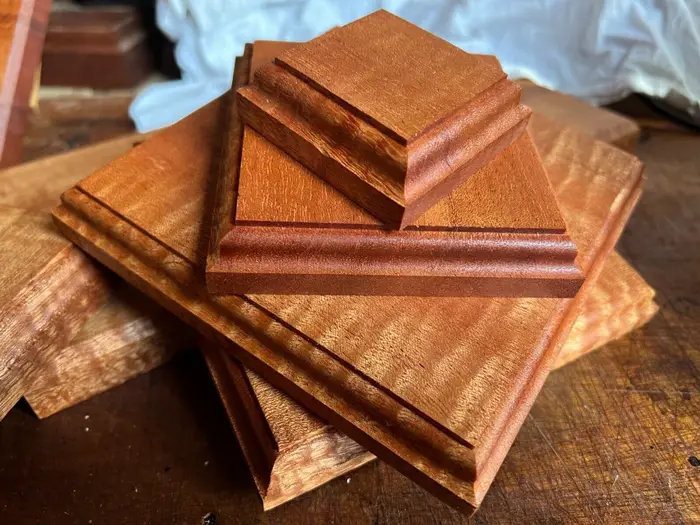
Mahogany is any of the three tropical hardwoods of the genus Swietenia. These species include Honduran, Cuban, and Swietenia humilis mahogany. Honduran mahogany is the most popular and widespread mahogany species. These species are also commercially grown in some places.
The following list compares the two hardwoods based on various factors.
1. Appearance
Walnut and mahogany differ from each other in color and grain pattern. Walnut trees usually have a light brown and dark color based on the type. Black walnut is usually chocolate brown, while the English has a light brown color with darker streaks.
Mahogany wood is usually reddish-brown with a striped grain pattern. On the other hand, walnut grain patterns are irregular. Grain pattern usually determines the stability of wood, wood with straight grains being more stable.
2. Availability
Another difference between the two hardwoods is their availability in terms of location. Walnut species are common in the Northern Hemisphere, in North America, Europe, and Russia.
Mahogany is common in tropical regions on various continents, including Africa, Central and South America, and Asia.

3. Price
These both vary in price, with walnut being cheaper than mahogany. Usually, the cost per square foot for a walnut wood can range between $2 and $8. A square foot of mahogany wood costs between $6 and $10.
However, the price varies with location and nearness to the wood source. The price may also vary with the species and type of wood you choose.
4. Durability
Mahogany is usually more durable as it’s denser, resisting scratches and dents. It also contains tannins and natural oils, including 1,8-Cineole, which help resist rot, decay, and insect damage. However, walnut, being a hardwood, is more resistant to impact from heavy use.
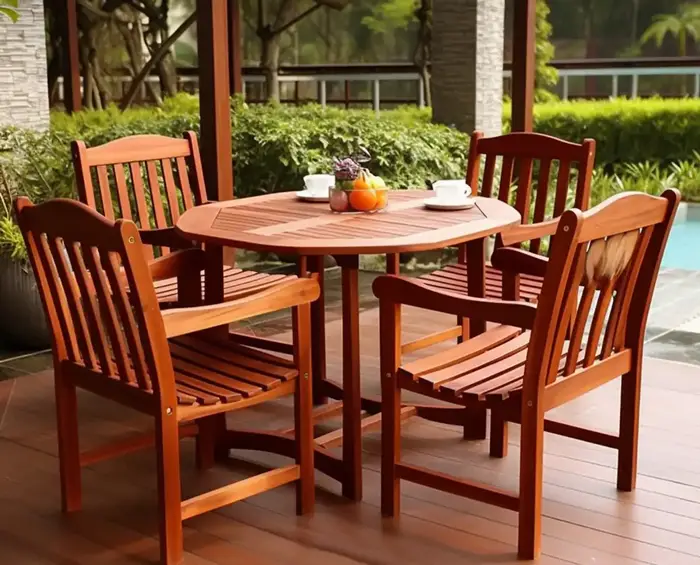
5. Weight
Walnut and mahogany vary in weight, with mahogany weighing slightly more than walnut. Mahogany weighs approximately 3.6 lbs. per board foot, while walnut wood weighs around 3.3 lbs. per board foot. However, the weight varies with the wood species and type.
6. Work Suitability
The two hardwoods vary with the projects that they are suitable to be used on.
Some of the projects suitable for mahogany include;
- Outdoor furniture: Mahogany’s durability makes it ideal for making outdoor furniture. Outdoor furniture is exposed to various weather elements and must be durable.
- Boats: Mahogany is more resistant to water and durable, which makes it ideal for boats
- Instruments: The density and resonance of the mahogany wood make it suitable for various musical instruments, including guitars and mandolins.
- Cabinetry: Mahogany is suitable for high-end cabinetry thanks to its rich color and grain pattern.
On the other hand, projects that are suitable for walnut wood include;
- Decoration: Walnut has an appealing grain pattern that most people find ideal for decorations. This wood can be used for molding, paneling, and trimming.
- Carving: Walnut wood has a fair texture and it is soft. These two qualities make them suitable for carving projects.
- Indoor Furniture: Walnut wood is suitable for making indoor furniture that requires elegance. The wood is easy to work with and has a warm color for furniture.
- Crafting: As earlier stated, walnut wood is soft and easy to work with, which makes it suitable for crafting. The wood is also ideal for making toys.
Which Will Be Suitable for My Project?
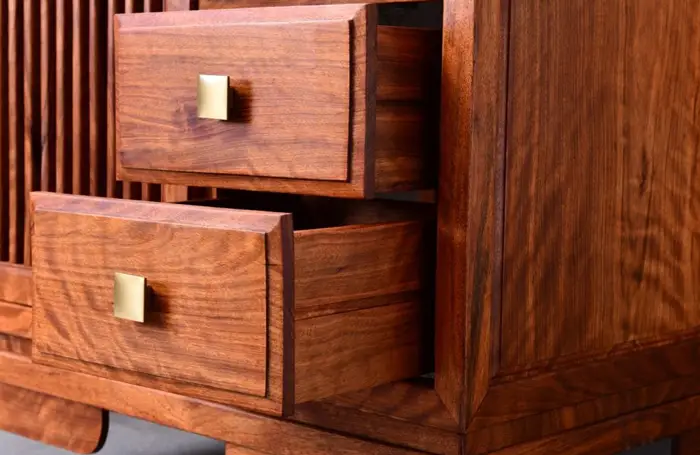
While walnut and mahogany can get the job done, the choice of hardwood to use on a specific project can be based on other factors. They include
1. Project Type
As stated in the above section, the types of projects that walnut and mahogany woods suit vary. If you’re working on an outdoor project, you ought to go for mahogany. Otherwise, use walnuts if dealing with an indoor project.
2. Wood Availability
The location where you’re taking the project can also determine the wood to use. Use the readily available walnut wood if in Northern locations, including Europe and North America.
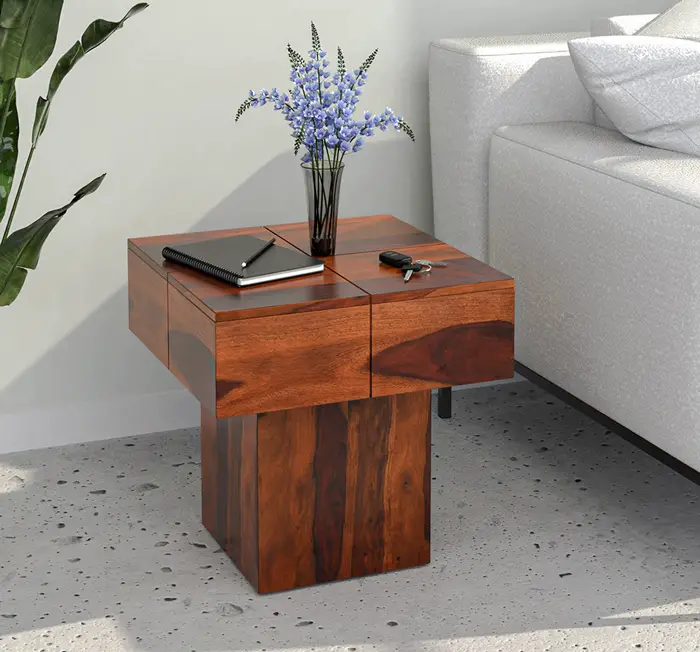
However, use mahogany if your project is in tropical regions, like Central or South America. However, some people commercially grow mahogany, which may also be abundant in some countries in North America.
3. Wood length
Tree size can be a determining factor when deciding on the hardwood to use between the two. The taller walnut, capable of growing over 120 feet, is suitable for larger projects that require longer wood.
However, if the wood length is not a concern, you can use mahogany, which usually grows under 100 feet.
4. Odor
Like most trees, walnut and mahogany trees have an odor, usually caused by terpene compounds. Walnut has a mild nutty aroma that some people find sweet to smell. If you’re sensitive to smell, this hardwood is the better choice.

On the other hand, mahogany has a bit stronger, spicier, and woodier odor. This smell is usually like that of cinnamon and is noticeable on freshly cut wood. Mahogany aroma is appealing to many and is usually one of the reasons they use it.
5. Cost
Another determining factor when choosing between the two hardwoods is cost. Usually, the price is affected by location, with wood readily available in the area being cheaper. However, walnut is usually cheaper than mahogany and should be your choice if you’re on a budget.
If you’re torn between choosing walnut or mahogany wood for your project and need insights, our guide on how to hide wood filler after staining might offer techniques to achieve a flawless finish. Additionally, if you’re wondering what to do with wood chips resulting from stump grinding, our article on what to do with wood chips from stump grinding provides creative solutions. We understand the importance of achieving the best finishes and addressing specific application techniques, and our comprehensive resources are designed to help you navigate and make informed choices for your woodworking projects.FAQs
The following section covers some of the common questions people ask including their answers.
Q1. Can I Use Walnut and Mahogany Together in a Project?
It’s possible to use walnut and mahogany in one woodworking project. The two hardwoods are both easy to work with and fairly durable, which can be advantageous to your project. Also, they can make unique designs due to their diverse grain patterns and color, resulting in an appealing wood item.
Q2. Are Both Walnut and Mahogany Suitable for Music Instruments?
Walnut and mahogany are suitable for making various musical instruments, including guitars. However, the tone of these instruments varies, with those made with walnut wood having a warmer tone. Mahogany instruments usually have a strong midrange and sustain.
Q3. Can Walnut Wood be Used in Outdoor Furniture?
It is usually not advised to use walnut wood to make outdoor furniture. While the wood is strong and durable, it can eventually get damaged by the changing weather elements. Also, it is more susceptible to insect damage, especially if untreated.
Bottom Line
Walnut and mahogany are usually top choices for wood projects as they are easy to work with and appealing. However, the two hardwoods vary in many ways, including their appearance, cost, and durability. Mahogany is denser and more durable, while walnut is cheaper and has a mild odor.
The decision on the hardwood to use on your project should be based on the various factors mentioned in the article. However, the most crucial factor is the type of project since the two hardwoods suit different projects better. Don’t hesitate to request professional advice for more pointers on the wood to use.




